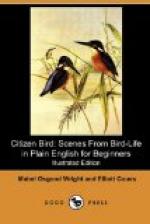“You all know the Pigeons that are kept about stables and barnyards. You have often seen them walking with dainty steps to pick up their food, and have heard the soft crooning ‘coo-oo’ they give when talking to each other. They all belong to the Birds that Coo. Their food is taken into the crop, which can be plainly seen when it is quite full. These birds feed their young in the same way Hummingbirds and Flickers do; for they give the little ones softened food from the crop, mixed with a sort of milky fluid that also comes from the crop. One habit that Pigeons and Doves have, all their own, is that in drinking they do not raise the head to swallow like other birds, but keep the beak in the water until they are through.
“Our domestic Pigeons have beautiful and varied plumage, but to my mind many wild species surpass them. The two best-known wild species are the Passenger Pigeon of the Northwest, and the Mourning Dove, which may be found nesting everywhere in temperate North America.
“Here are the two birds”—and the Doctor set them upon the table. “At first glance you may think them much alike, and if you should see them on the wing you would surely be confused.
“Rap, you may describe the Passenger Pigeon, and Nat shall take the Dove; let me see if you can do it clearly enough for your written tables.”
[Illustration: Passenger Pigeon.]
Rap looked at the Pigeon for some time. “It isn’t an easy bird to describe—all the colors run together so. It has bluish-gray upper parts, and underneath it is a sort of pinky brown with white under the tail. The sides of the neck are shiny with soap-bubble colors. The outside tail-feathers are bluish and fade off white at the tips, but the middle ones are all dark; the beak is black, and the feet are red. But see here,” he added, as he looked sharply at the bird’s tail again, “there are some chestnut and black spots at the roots of the side feathers.”
“Very good, my boy. How long do you think it is?”
Rap measured with his finger and said he thought about fourteen inches.
“You are almost right, though these Pigeons vary in length, because some have longer tails than others. I think this one measured about sixteen inches when it was stretched out straight; but it looks shorter now, because it is set up in a natural position.
“The life history of this beautiful Pigeon should teach every one the necessity of protecting birds by law. Up to fifty years ago the Passenger Pigeon was extremely plentiful everywhere east of the great plains—there were many millions in a single flock sometimes. It was a most valuable bird, its flesh being particularly well-flavored and tender. It nested in large colonies that often stretched unbroken for many miles in the woods, and was both hardy and prolific. If it had been protected in the breeding season and hunted fairly as an article of food at other times, we should still be enjoying Pigeon pie as freely as we did in my boyhood. But as the population of the country increased, these great flocks were cruelly slaughtered, for the mere greed of killing them; thousands were often left to decay upon the ground, and now I do not believe that any one of you has ever seen a wild Pigeon before to-day.”




